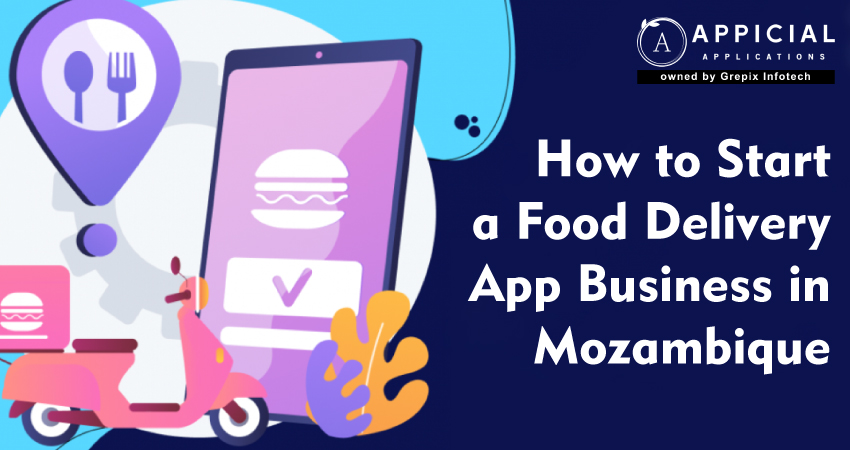
How to Start a Food Delivery App Business in Mozambique
Mozambique is changing.
Grocery stores are modernizing. Supermarkets are spreading in Maputo and Beira. More people use their phones for daily tasks.
Still, delivery apps remain rare.
Most food orders happen by phone or walk-in. Restaurants use WhatsApp or manual tracking. Long wait times, missed orders, and disgruntled customers are the results of that.
People want something better.
They want their food fast. They want to track it. They want to pay online when they can.
That’s where the importance of a food delivery app comes into play!
It creates a seamless connection between customers, eateries, and couriers. It makes things easier. It leads to business expansion.
In 2025, the timing is right. Tech is available. Internet use is rising. People are ready.
So, let’s explore how to build a successful platform from scratch in Mozambique.
Mozambique’s online food delivery market is fast expanding, with projected revenue of US$61.21 million by 2025 and annual growth at about 16–17% through 2030. While household food spending is huge (nearly US$7 billion in 2025), online orders still account for just a small fraction. Consumers in urban centers like Maputo and Beira are seeking ease and variety. Restaurants want new sales channels. Reliable, local food ordering apps are rare. This blog dives into why building a food delivery app makes sense in Mozambique, what features you need, the right tech stack, costs and timeline, local challenges, and how Appicial Applications can help you launch smarter.
Why Invest in Food Delivery App Development in Mozambique?
Here’s why now is the ideal time:
1. Rapid Market Growth
Online food delivery revenue in Mozambique is expected to reach US$61.21 million in 2025. Users are growing fast, with internet penetration expanding in cities.
2. Large Food Market with Low Online Penetration
Total food spending is expected to reach US$7 billion in 2025, but only about 0.5–1.1% of that occurs online. That gap presents an opportunity.
3. Urban Consumer Demand
Busy professionals, students, and working families need convenience. They want food ordering apps for daily meals and treats.
4. Limited Existing Delivery Solutions
Few apps offer complete delivery services. That means less competition. There’s space for a well-built, locally adapted platform.
5. Room for Diverse Cuisine
Mozambican food, like matapa, xima, and grilled prawns, is rich and varied. A food delivery app can bring both traditional and fusion cuisine to customers easily.
6. Growing Digital Payment Adoption
Mobile wallets and card usage are increasing. Customers are more comfortable with online payments. Those fuel convenience-based platforms.
7. Tech Evolution and Q-Commerce Trends
Faster delivery models (Q-commerce) and AI recommendations are two innovations that are gaining popularity worldwide and may soon be applicable in Mozambique.
These elements make it not only feasible but also promising for food delivery app development in Mozambique.
Which features are essential to develop a food delivery app?
Your app must have powerful features in order to satisfy user expectations and foster trust:
Customer App
- Easy sign-up via phone or email
- Browse restaurants and menus
- Search filters (cuisine, price, time)
- Estimated delivery time and real-time tracking (DoorDash delivery app style)
- Secure payments via card or digital wallet
- Order history, ratings, and reviews
- Push or SMS notifications
Restaurant Partner App
- Order notifications
- Accept or reject incoming orders
- Input preparation time and status updates
- Dashboard to track sales, orders, and trends
Courier App
- Accept delivery tasks
- Integrated navigation and best route suggestions
- Status updates: pickup, in transit, delivered
- Earnings summary and history
Admin Dashboard
- Monitor orders, drivers, and restaurants
- View analytics such as peak times, cancellations, and delivery time
- Manage promotions, discounts, and service zones
- Support tools for customer queries
These features, which are customized for the local reality of Mozambique, are in line with user experiences on international platforms such as Grubhub delivery and DoorDash food delivery.
What is the Technology Stack and Architecture?
Here’s a solid structure to build your app:
Frontend (Web/Mobile):
React Native or Flutter for applications. For the admin dashboard, use Angular or React.
Backend:
Python (Django/Flask) or Node.js. Make use of PostgreSQL or MongoDB. Redis for caching.
APIs and integration:
Google Maps for navigation. Twilio or Firebase for notifications. Local payment gateways for wallet and card support.
Hosting:
AWS or DigitalOcean with servers nearer to Maputo for lower latency.
Architecture:
Modular design with separate zones for customer, restaurant, courier, and admin functions. Microservices enable scaling.
This setup ensures fast order flow, real-time status updates, and robust payments.
Also Read: Unlocking the Potential of Food Delivery App Development in Sudan
What are the Challenges and Market Gaps in Mozambique?
Launching a food delivery app here requires awareness of local barriers:
Low Internet Penetration
Nationally, only ~45% access to the internet, mostly in urban zones. Apps need to be lightweight and work on slower networks.
High Poverty Levels
Disposable income is still low for most. Services must be affordable and offer clear value.
Cash Preference
Many still prefer cash on delivery. Support both cash and digital payments initially.
Trust and Reliability Issues
Unreliable service and missing deliveries hurt trust. Real-time tracking mitigates that.
Logistics Infrastructure
Roads outside cities can be poor. Delivery areas need smart planning and realistic ETAs.
Restaurant Digital Readiness
Many local eateries lack tech-savvy staff. Onboarding and training must be part of your offering.
Addressing these gaps directly helps your app stand out—and win trust.
What is the Estimated Development Cost & Timeline?
A well-planned build has two phases:
1. MVP Phase
Includes customer, restaurant, and courier apps; basic tracking; payments; admin dashboard.
- Time: 3–4 months.
- Estimated Cost: US$20,000–$35,000.
2. Advanced Phase
Add loyalty programs, promotions, AI-based recommendations, and support tools.
- Time: Additional 3–5 months.
- Estimated Cost: US$35,000–$60,000+.
Post-launch costs include hosting, support, training, and updates. Launch lean, then add features based on user feedback.
How Appicial Applications Can Help?
At Appicial Applications, we combine global best practices with deep local understanding:
- Pre-built Templates: Mirror user flows of Grubhub delivery or DoorDash food delivery, but optimized for Mozambique.
- Local Payment Integrations: We support local wallet and card gateways preferred in Mozambican urban areas.
- Lightweight, Optimized UI: Works on low-bandwidth networks and older Android phones.
- Restaurant Onboarding: We assist with integrating shops, training staff, and managing menus.
- Scalable Architecture: Modular design supports future growth, dark kitchens, Q-commerce, and grocery add-ons.
- Post-launch Support: From marketing help to technical updates and customer support tools.
We’re not just a vendor. We’re your partner in launching a successful food delivery app.
Conclusion
So, there you have it! That’s a complete wrap to the food delivery app development in Mozambique. There is no denying the fact that Mozambique’s food delivery market is breaking new ground. By 2025, online meals will generate over US$61 million, with strong growth ahead. Urban consumers want convenience. Restaurants need tools. Digital payment habits are growing.
A locally focused, user-friendly food delivery app development business can serve that need and build a meaningful brand.
Focus on core features, low-data performance, integrations for payments and navigation, and support for restaurants. Start small in Maputo or Beira, test your model, iterate, then expand.
With the right tech, design, and a partner like Appicial Applications, you can launch fast and scale smart. We have a dedicated team of food delivery app development experts who don’t just build scalable apps but also market them using the modern tech stack and agile methodologies to drive tangible business results.
Now is the time. The market is opening. People are ready.
FAQs
Author's Bio

Vinay Jain is the Founder at Grepix Infotech and brings over 12 years of entrepreneurial experience. His focus revolves around software & business development and customer satisfaction.
Back to blog list




